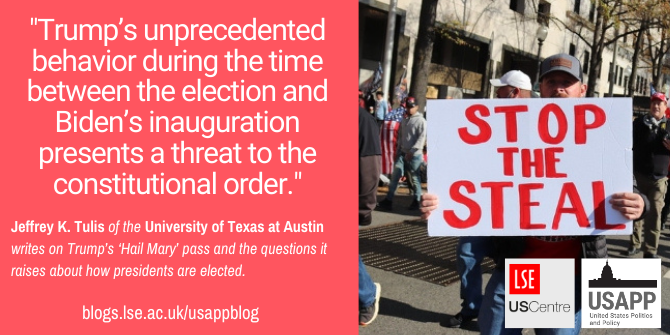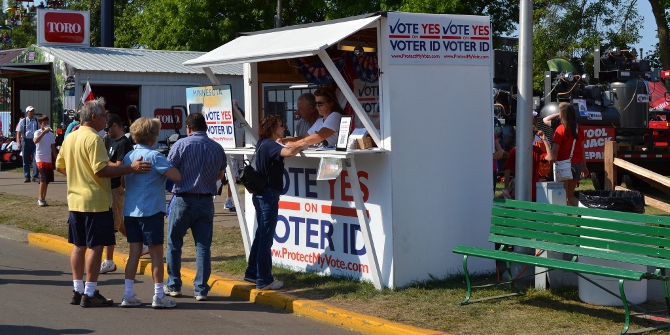 Despite media projections that Joe Biden is the winner of the 2020 presidential election, Donald Trump continues to make claims to the contrary. Jeffrey K. Tulis writes that Trump’s legal challenges to vote counts and pressure on state officials to change their Electoral College votes in closely contested states are a “Hail Mary” tactic to keep the presidency. Contrasting Trump’s current efforts to influence the Electoral College with 2016 calls for electors to be “faithless” and to not vote for Trump, he writes that the Electoral College has lost one of its original functions: to prevent demagogues from entering the White House.
Despite media projections that Joe Biden is the winner of the 2020 presidential election, Donald Trump continues to make claims to the contrary. Jeffrey K. Tulis writes that Trump’s legal challenges to vote counts and pressure on state officials to change their Electoral College votes in closely contested states are a “Hail Mary” tactic to keep the presidency. Contrasting Trump’s current efforts to influence the Electoral College with 2016 calls for electors to be “faithless” and to not vote for Trump, he writes that the Electoral College has lost one of its original functions: to prevent demagogues from entering the White House.
Donald Trump has claimed that he has won the 2020 presidential election even though all the major networks and news organizations, including Fox News, projected Joe Biden to be the winner with 51 percent of the popular vote and 306 electoral votes. Trump filed numerous legal challenges and has attempted to pressure Republican state legislators to ignore the apparent popular vote results in battleground states and instead designate a slate of electors pledged to him. This strategy has been labeled Trump’s “Hail Mary” (so-named after a type of long pass in football played at a desperate time in the game).
Four years ago, at this point in the electoral cycle, the same major news organizations projected Trump to win the election by the same number of electoral votes, 306. Because Trump’s campaign was so excessively demagogic and because his actions and behavior portended a president who would abuse his power, Jeremi Suri, Sanford Levinson and I wrote an Op Ed for the New York Daily News that proposed a “Hail Mary” campaign to persuade Republican electors to vote for someone other than Trump when the Electoral College met to decide the contest. At the time, we also published a revised version here.
Now, Suri, Levinson and I believe that Trump’s unprecedented behavior during the time between the election and Biden’s inauguration presents a threat to the constitutional order. We think that his attempts to thwart the process in 2020 are anti-constitutional and autocratic. Are we hypocrites? Was our controversial argument in 2016 for conscientious electors to deny victory to the apparent winner a precedent for Trump’s argument today? Was our “Hail Mary” a precedent for Trump’s “Hail Mary?” I think not.
“Hail Marys” of 2016 and 2020, and the Electoral College
Our argument was that Trump was unfit for office even though he had won the popular vote in sufficient states to meet the threshold for a majority of Electoral College votes. We did not claim that the counting of ballots was corrupt or flawed. We did not claim that he had lost the popular votes in the states that determined the outcome. We did not claim that Hillary Clinton deserved to win because she won the national popular vote by a substantial margin.
Rather, we claimed that the Electoral College was designed to prevent exactly the kind of outcome that Trump represented—a demagogue who would subvert the constitutional order. Although the Electoral College had long ceased to function as deliberative bodies meeting state by state, and instead had become a mere counting mechanism, the Constitution had never actually been amended. The Electoral College thus remained a viable resource to contend with the problem for which it was originally designed.
Our essay went viral and was one of the opening salvos in what came to be a national movement known as the “Hamilton Electors” campaign. The campaign was so named to highlight Alexander Hamilton’s argument in The Federalist that the Electoral College would insure that demagogues be barred from the presidency and that foreign influence in our electoral system might be thwarted. At the time we invoked Hamilton, concerns were already pronounced that Russia had supported Trump’s election and may have colluded with his campaign.
The Electoral College had long ceased to be a set of deliberative bodies, so electors who departed from their pledges to specific candidates were called “faithless.” Most states had strong norms against such independence of judgment and political parties sought to choose prospective slates of electors who would be faithful to their pledge. Some states passed laws codifying the norm and some included punishment for violating it. We relabeled persuadable electors as “conscientious” electors. Rather than faithless to their parties, these electors would be conscientiously faithful to the Constitution. We argued that state laws that attempted to bind or punish electors were unconstitutional because provisions for the Electoral College were never amended and the institution presupposed individuals with discretion and judgment.
Because our central concern was Trump’s unfitness for office—not the veracity of the electoral count, we sought to honor the will of the voters and deny the Trump election at the same time. We urged Republican electors to vote for some Republican other than Trump to honor the policy and programmatic preferences of the voters who prevailed. For example, we suggested that they might possibly vote for Mike Pence who was on the same winning ticket. We sought to persuade at least 37 Republican electors to vote for someone other than Trump in order to push the decision into the House of Representatives, which would vote by state delegation, the majority of which were controlled by the GOP. We also urged Democratic electors to join their GOP colleagues in voting for some Republican other than Trump, rather than for Clinton to whom they were pledged, to reinforce the point that the GOP had won the election but that Trump was unfit and dangerous.
The campaign failed to even come close to pushing the election to the House. It did, however, produce the highest number of so-called faithless electors in American history—five Democratic electors and two Republicans. Both Republicans were from Texas. Some of the Democrats had violated state law and their votes were challenged all the way to the Supreme Court which decided that states could bind their electors and could punish them for violations. Texas does not have such laws so the two conscientious electors’ votes from Texas stood. Thus, Trump did not actually obtain 306 votes in 2016 as projected. His final total was 304. History will record that Trump’s self-described 2016 “landslide” was smaller than Biden’s 2020 victory.
Why Trump’s “Hail Mary” play won’t work
One should already have a sense of how different Trump’s “Hail Mary” effort is from the one that we mounted. First, Trump is mounting a challenge on his own behalf, in his own personal interest. In our case, Clinton had conceded the election to Trump and played no part in the Hamilton Electors movement. Had the movement succeeded it would not have elevated her to the presidency. People who had supported Clinton initiated the Hamilton Electors movement, but it was not conducted on her behalf. Second, Trump is challenging the integrity of the vote count; we challenged the integrity of Trump. Earlier in the campaign season, questions were raised about Biden’s mental capacity, about whether he might have dementia. Should supporters of Trump appeal to electors to choose some Democrat other than Biden because the former Vice President is no longer fit for office that would be similar to the Hamilton Electors effort. Of course, in the debates and late stages of the campaign, Biden showed that he is mentally fit, so the claim is unwarranted. But this kind of claim would be similar to the argument we made in 2016. Third, Trump has sought to persuade partisan state legislators to appoint a slate pledged to him despite his loss of the popular vote. He is not appealing to electors to be constitutionally conscientious; he is appealing to fellow partisans to be constitutionally contemptuous.

“IMG_4549” by Elvert Barnes is licensed under CC BY SA 2.0
The recent Supreme Court case on “faithless electors” makes future attempts to appeal to electors to violate their partisan pledges likely futile. In its unanimous verdict the Court decided that the constitutional provision that the state legislatures could determine the manner of choosing their electors, absent another constitutional constraint gave them complete latitude to determine the qualifications and commitments of their electors, and to punish electors for reneging on their commitments. The court also pointed to the long history of the actual practices of the Electoral College to demonstrate that for nearly all of American political history electors have not had independent discretion, nor was the Electoral College a deliberative body.
Can the Electoral College still stop a demagogue from taking office?
After this recent case, American constitutional law is now clear regarding the status of so-called “faithless electors.” Constitutional law, however, now is at odds with the best understanding of the Constitution itself and seeing why helps illuminate a deeper and more pervasive problem regarding justice-related approaches to constitutional understanding. The Court’s opinion on the faithless electors case illustrates the tendency of courts to elevate means over purposes. The Constitution does specify the means by which electors are to be chosen—by state legislatures given wide latitude. But it also specifies that electors be chosen—that is, an intermediate body distinct from the legislatures themselves. Why? Why have any additional body of individuals? Why not allow state legislatures to determine their allocation of votes for president by any manner they choose? One cannot account for the fact of an intermediate body without asking what its purpose is? Hamilton makes clear that the purpose of an intermediate body, like the purpose of representation more generally, is to filter popular will through a medium structured to improve or elevate it, or at a minimum to prevent popular will from subverting democracy itself. Demagogues posed the greatest threat to the presidency and to the entire constitutional order, in the argument of The Federalist. A principal purpose of the Electoral College was to prevent this possibility.
The long history of the Electoral College as a mere counting mechanism rather than as a deliberative body also supports the constitutional view that its purpose remained anti-demagogic. When the Constitution was ratified, its proponents were critics of political parties. Political parties needed to be reinvented in America to make them supplements and enhancements to the Constitution rather than problems for constitutional sustenance. One aspect of this reinvention of parties in America was the creation of a two-party system at the presidential level. Such a system inclined candidates to be moderates, to compete for the center. And, as originally designed, the parties themselves selected the candidates rather than voters in primaries as is the case in recent decades.
One of the main defenses for retaining an Electoral College that gives outsized influence to smaller states, and that could produce a winner that received less than a majority of the national popular vote, was that such a complex system produced better outcomes for democracy—candidates who were not demagogues. It does this with a structure that advantages the two major parties and disadvantages third party challenges. In the Electoral College framework, it is nearly impossible for a third party to mount a viable challenge to the major parties because the winner of each state’s popular vote captures the entire allocation of Electors. For third parties to be viable they would need to aggregate support across the nation, but the structure of the Electoral College precludes this.
Reconsidering the Electoral College
As Herbert Storing put it in testimony before a Senate committee considering an amendment to abolish the Electoral College, democracy is as much about outputs or outcomes as it is about inputs or process. A well-functioning democracy reflects popular opinion (inputs) but also serves popular interests (outputs). A democratic majority that chooses an undemocratic autocrat would be a suicidal democracy. Until our relatively recent primary-based selection system, the non-deliberative Electoral College continued to function, in a new way, to advance the same goal or purpose as the original deliberative version. It successfully served as a gate-keeper against demagogues.
Because the parties are now polarized, the case for a two-party system is weaker than it was when both parties competed for the center. And when at least one of the parties becomes hyper-partisan, which is to say interested in gaining power at the cost of abandoning principles and ideas for which the party purportedly stands, then the two-party system no longer functions to diminish the prospects of demagogues.
Purposes, whether they be institutional purposes like that of the Electoral College, or the purposes of government as a whole as outlined in the Preamble to the Constitution, are rarely the focus of judges. Rather, judges are inclined to highlight means over ends, to attend to process over purpose.
Because Clinton lost the election of 2016 even though she won the national popular vote by millions, and because Trump came very close to winning the Electoral College even though he lost the 2020 national popular vote by many more millions, there is renewed interest today in abolishing the Electoral College. As citizens ponder how to best select our president absent an Electoral College, they would do well to engage in a broader constitutional conversation than is common for the judiciary. Citizens need to ask themselves not only how to make it more certain that a national majority prevails; they need to continue to ask, as well, how do we prevent demagogues from ascending to the nation’s highest office?
- This article appeared originally at The Constitutionalist.
Please read our comments policy before commenting.
Note: This article gives the views of the author, and not the position of USApp– American Politics and Policy, nor of the London School of Economics.
Shortened URL for this post: https://bit.ly/39Ao9Zl
About the author
 Jeffrey K. Tulis – University of Texas at Austin
Jeffrey K. Tulis – University of Texas at Austin
Jeffrey K. Tulis is a professor of government at the University of Texas at Austin and the author of The Rhetorical Presidency and the co-author of Legacies of Losing in American Politics.






